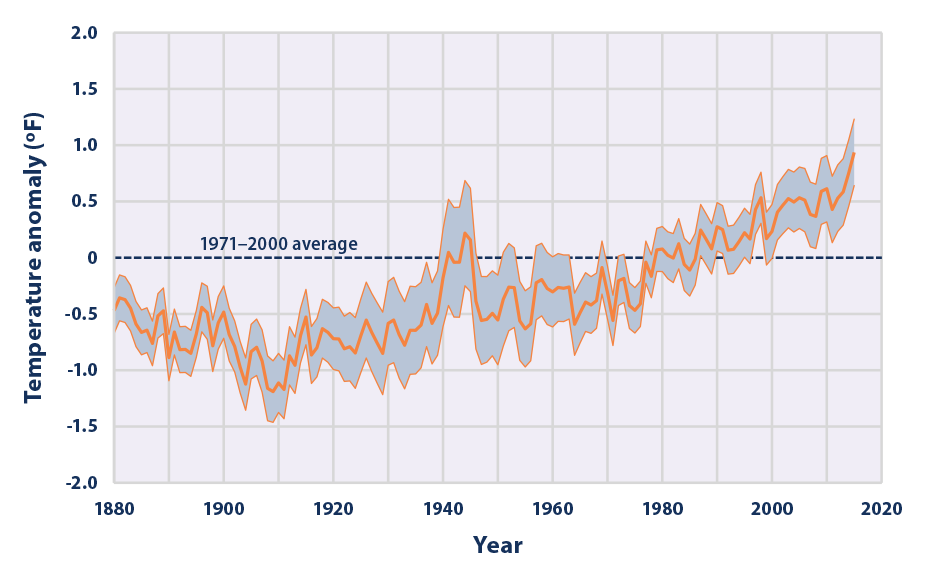Sea Surface Temperature
This map shows how average sea surface temperature around the world changed between 1901 and 2015. It is based on a combination of direct measurements and satellite measurements. A black “+” symbol in the middle of a square on the map means the trend shown is statistically significant. White areas did not have enough data to calculate reliable long-term trends.
Data source: IPCC, 20137; NOAA, 20168
Web update: August 2016
This graph shows how the average surface temperature of the world’s ocean has changed since 1880. This graph uses the 1971 to 2000 average as a baseline for depicting change. Choosing a different baseline period would not change the shape of the data over time. The shaded band shows the range of uncertainty in the data, based on the number of measurements collected and the precision of the methods used.
Data source: NOAA, 20166
Web update: August 2016
SEA SURFACE TEMPERATURE OF THE OCEAN HAS BEEN CONSISTENTLY HIGHER DURING THE PAST THREE DECADES THAN AT ANY OTHER TIME SINCE RELIABLE OBSERVATIONS BEGAN IN 1880.
As heat continues to build up in the ocean, the surface layers are warming. Globally, sea surface temperatures have warmed by about 1.5°F since the beginning of the 20th century. Since 2004, the Gulf of Maine has warmed faster than 99.9% of the global ocean and could rise more than 4°F if global carbon emissions continue to increase. It’s a dramatic change that studies have linked to a northerly shift in the Gulf Stream.
Summer is coming to the Gulf of Maine, longer and warmer than ever - as much as two months longer. Oceanography professor Andrew Thomas has studied this trend and the potential ramifications of this major shift in temperatures and seasons in the Gulf.
On August 8, 2018, NOAA satellites measured an average sea surface temperature of 68.93°F (20.52°C) in the Gulf of Maine, which fell just shy of a record set in 2012. The Gulf of Maine stretches from Cape Cod to southern Nova Scotia. Scientists believe that climate change may be responsible for the warming waters. As melting glaciers in Greenland dump more freshwater into the North Atlantic, the ocean circulation that keeps waters along the coast of eastern North America cold may be starting to weaken – allowing more warm water to pool into the Gulf of Maine.
Long Island Sound is also experiencing warmer water temperatures. In 1976, average spring water temperature was recorded at about 43 degrees; by 2008, it was almost three degrees warmer. Autumn temperatures followed a similar trend: an average of 65.7 degrees in 1976, and 68.5 degrees 32 years later.
Large sections of the global oceans have warmed 1°-3°F during the last century, with some buoy locations having a more dramatic rise recently. Warmer water fuels hurricanes, and not surprisingly, the average number of major hurricanes — those Category 3 or higher — has increased in the Atlantic basin since the 1970s. Globally, climate models project that there will likely be an increase in the wind speed and rainfall intensity of the strongest hurricanes (aka tropical cyclones), even though their frequency may remain unchanged or even decrease by the end of this century. However, the extent of these effects from climate change will vary by region.
When we talk about a warming climate, we often focus on air temperatures. Only 7 percent of the excess energy trapped in the climate system by increasing greenhouse gases goes into the land, air, and ice, though, while 93 percent of that energy goes into the oceans. The water temperature rise is slow and steady, as it takes 4 times more energy to raise the temperature of water compared to the air.
While warmer coastal waters might seem beneficial to a variety of aquatic species, the negative impacts could outweigh any gains. In 2009, David Biello reported in Scientific American that increasing sea surface temperatures are having an adverse impact to aquatic food webs. Researchers found that increasing temperatures, although initially enhancing the growth of phytoplankton, also allowed increased grazing by zooplankton (microscopic animals) and bacteria, according to the results published today in PLoS Biology. As temperature rises, the zooplankton start to grow faster than the phytoplankton. The zooplankton are more abundant and faster-growing, and are able to eat all the phytoplankton in warmer water. This creates a bottleneck in the food chain that could have large implications for the ocean's food web. Not only does that mean that there are fewer phytoplankton around to suck up carbon dioxide, but it could also mean less food for other grazers. But it does not necessarily mean that the zooplankton will gorge themselves to death; other research has shown that food webs with more animals (consumers) than plants (producers) is sustainable for at least five years. And animals higher on the food chain, ranging from fish to whales, will feast on zooplankton, such as krill. Boosting the number of zooplankton, however, means the overall mass of ocean life declines: the tiny animals metabolically burn 90 percent of the phytoplankton they consume, incorporating only 10 percent. All told, with a 6-degree Celsius rise in water temperature, total biomass in the warmest microcosm shrank by 50 percent.
AFFECTS TO COASTAL WILDLIFE
Photo taken at Maritime Aquarium, Norwalk, CT
American Lobsters (Homarus americanus):
Warmer sea surface temperatures are forcing lobster populations northward. The lobster industry in Long Island Sound and in southern New England has virtually collapsed. Since 1996, New York’s registered lobster landings dropped more than 98%. Connecticut is seeing the same, with a drop of about 97%, and Rhode Island’s lobster landings has declined by more than 70%. While southern New England is losing lobsters, the cooler waters in the Gulf of Maine are reaping the benefits with a 219% increase in registered lobster landings since 1994.
Blue-Claw Crabs (Callinectes sapidus):
According to Mass Audubon, historically, Cape Cod marked the northern extent of blue crabs’ range. They were found south of the Cape, but not north. In recent years, that has change with warming waters and an enhanced gulf stream.
It’s unlikely that blue crabs will be able to reliably breed in cooler waters north of Cape Cod anytime soon. They may, however, increase in population along the Jersey Shore and off of New York State, and during warm years, gain a temporary foothold in the Gulf of Maine.
Arctic cod (Boreogadus saida):
This cold water fish generally swims in waters at about 0 degrees Celsius, or even colder, as saltwater has a lower freezing point than freshwater does. Once water is warmed to 2.5 degrees Celsius or 36.5 degrees Fahrenheit, growth of Arctic cod is stunted compared to that of the other tested species, such as pollack and Pacific cod, according to preliminary results. Waters warmed to above 41 degrees Fahrenheit are fatal to Arctic cod eggs the scientists found.
Atlantic Tomcod (Microgadus tomcod):
This fish, also known as winter cod, was once found as far south as Virginia. Tomcod is a type of cod fish found in North American coastal waters from the Gulf of St. Lawrence, St. Lawrence River and northern Newfoundland, south to Virginia. But tomcod hasn’t been found anywhere south of the Hudson River, NY since the 1980s; and the Hudson River population for Atlantic tomcod is showing considerable year-to-year variation. At this time the fish appears to be in a long-term decline [1]. Atlantic Tomcod is an anadromous fish, which means it lives in salt water, but also lives part of its life in fresh water, in this case it’s breeding season.




